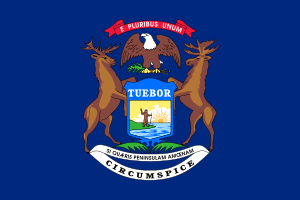John Biddle (Michigan politician)
| John Biddle | |
|---|---|
 | |
| Member of the U.S. House of Representatives from Michigan Territory's At-large district | |
|
In office March 4, 1829 – February 21, 1831 | |
| Preceded by | Austin Eli Wing |
| Succeeded by | Austin Eli Wing |
| 4th Mayor of Detroit, Michigan | |
|
In office 1827–1828 | |
| Preceded by | Jonathan Kearsley |
| Succeeded by | Jonathan Kearsley |
| Personal details | |
| Born |
March 2, 1792 Philadelphia, Pennsylvania |
| Died |
August 25, 1859 (aged 67) White Sulphur Springs, West Virginia |
| Citizenship | United States |
| Nationality | United States |
| Residence | Detroit, Michigan |
| Alma mater | Princeton College |
| Military service | |
| Allegiance |
|
| Service/branch | United States Army |
| Years of service | 1812–1821 |
| Rank | Major |
| Battles/wars | War of 1812 |
John Biddle (March 2, 1792 – August 25, 1859) was a delegate to the United States Congress from the Michigan Territory.
Early life and military career
Biddle was born in Philadelphia, Pennsylvania in 1792, the son of Charles Biddle, former Vice President of Pennsylvania,[1] and nephew of Commodore Nicholas Biddle.[2] He attended the common schools before entering and graduating from Princeton College.[3] At the outbreak of the War of 1812, Biddle enlisted in the U.S. Army and was appointed a second lieutenant in the Third Artillery on July 6, 1812 and promoted to first lieutenant March 13, 1813.[3] He was attached to the staff of General Winfield Scott on the Niagara Frontier for most of the war. He became captain in the Forty-second Infantry October 1, 1813, served as assistant inspector general with the rank of major from June 19, 1817 to June 1, 1821,[3] and commanded Fort Shelby in Detroit for some time.[1]
After leaving the military, Biddle was appointed paymaster and Indian agent at Green Bay, Wisconsin in 1821 and 1822.[3] He was register of the land at Detroit, Michigan in of Michigan Territory, 1823–1837; commissioner for determining the ancient land claims at Detroit, Mackinaw, Sault Ste. Marie, Green Bay, and Prairie du Chien.[3]
He married Eliza Falconer Bradish (1795–1865) of New York.[1] The couple had four children that lived to adulthood: Margaretta Falconer Biddle (1825–1913), William Shepard Biddle (1830–1901), Major James Biddle (1833–1905) and Edward John Biddle (1836–1892).[4]
Politics and civic leadership
Biddle served as mayor of Detroit in 1827 and 1828.[3] He was elected a Delegate from the Territory of Michigan to the Twenty-first Congress and served from March 4, 1829 until his resignation on February 21, 1831.[3] He was president of the convention that framed the State constitution for Michigan in 1835, even though his Whig Party was in the minority.[2] He ran unsuccessfully as the Whig candidate[2][5] for election to the United States Senate and later for Governor of Michigan.[3] Biddle was a member of the Michigan State House of Representatives in 1841 and served as speaker,[3] and was a Trustee of the University of Michigan.[1]
Biddle was president of the Michigan Central Railroad.[3] He also served as the first President of Farmers’ and Mechanics’ Bank, and was a bank Director from 1829 through 1838.[1] He was also active in the civic life of Detroit, being elected Vice President of the Detroit Athenaeum, active in the Association for Promoting Female Education in the City of Detroit, and Vice President (1828–1837) and President (1837) of the Historical Society of Michigan.[1]
Wyandotte
In 1818, Biddle acquired 1,800 acres (7.3 km2) of land south of Detroit.[1] He constructed a summer estate on the land, completed in 1835.[1] Biddle named his estate "Wyandotte" after the Native American people who had once lived there.[1] Biddle's home stood where the George P. MacNichol House how sits.[1]
Retirement
Biddle and his family retired to the Wyandotte estate in 1836.[1] However, Biddle was uninterested in farming the estate,[1] and spent much time on his estate near St. Louis, Michigan.[3] In 1853, he sold the Wyandotte estate to Eber Ward of Eureka Iron, who developed the area into the city of Wyandotte, Michigan.[1] Jefferson Avenue, which stretches from New Baltimore, Michigan to East Rockwood, Michigan, is named Biddle Avenue through Wyandotte.
After selling the Wyandotte estate, Biddle and his wife returned to Philadelphia, and later the couple spent much time in Paris.[1] In 1859, Biddle went to White Sulphur Springs in what is now West Virginia, for the summer, and died there.[3] He is interred in Elmwood Cemetery, Detroit, Michigan.[3]
His grandson (William Shepard Biddle's son), also named John Biddle (1859–1936) became Superintendent of the United States Military Academy.[4]
References
- 1 2 3 4 5 6 7 8 9 10 11 12 13 14 "Major John Biddle". Elmwood Cemetery. Retrieved September 10, 2010.
- 1 2 3 Carlisle, Fred, ed. (1890), Chronography of Notable Events in the History of the Northwest Territory and Wayne County, Detroit: O.S. Gulley, Bornman, pp. 237–238, OCLC 13694600
- 1 2 3 4 5 6 7 8 9 10 11 12 13 United States Congress. "John Biddle (id: B000441)". Biographical Directory of the United States Congress.
- 1 2 Owen Picton (May 2004). "Descendants of William Biddle III". Retrieved March 16, 2011.
- ↑ Lawrence Kestenbaum (10 March 2005). "Index to Politicians: Biddle". Political Graveyard. Paul Haas. Retrieved 2006-07-06.
| Political offices | ||
|---|---|---|
| Preceded by Jonathan Kearsley |
Mayor of Detroit, Michigan 1827–1828 |
Succeeded by Jonathan Kearsley |
| United States House of Representatives | ||
| Preceded by Austin Eli Wing |
Delegate to the U.S. House of Representatives from Michigan Territory 1829–1831 (5th of 8) |
Succeeded by Austin Eli Wing |


